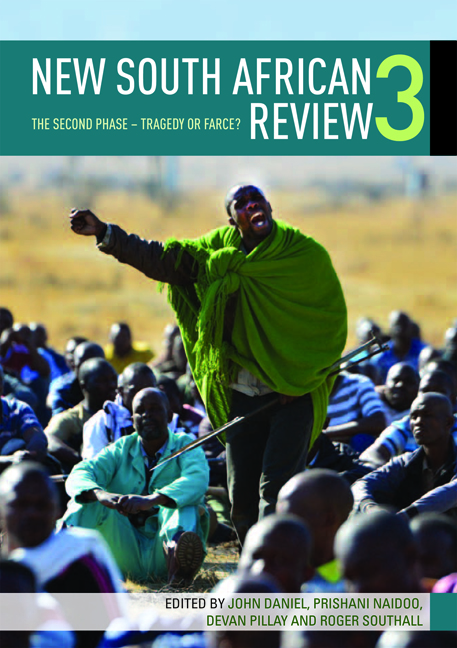Book contents
- Frontmatter
- Contents
- Preface
- Introduction: The second phase – tragedy or farce?
- PART 1 Party, Power and Class
- PART 2 Ecology, Economy and Labour
- Introduction: Ecology, economy and labour
- Chapter 5 Mass unemployment and the low-wage regime in South Africa
- Chapter 6 Nationalisation and the mines
- Chapter 7 Broad-based BEE? HCI's empowerment model and the syndicalist tradition
- Chapter 8 ‘Ask for a camel when you expect to get a goat’: Contentious politics and the climate justice movement
- Chapter 9 Hydraulic fracturing in South Africa: Correcting the democratic deficits
- PART THREE Public Policy and Social Practice
- PART 4 South Africa at Large
- Contributors
- Index
Chapter 5 - Mass unemployment and the low-wage regime in South Africa
from PART 2 - Ecology, Economy and Labour
Published online by Cambridge University Press: 31 May 2019
- Frontmatter
- Contents
- Preface
- Introduction: The second phase – tragedy or farce?
- PART 1 Party, Power and Class
- PART 2 Ecology, Economy and Labour
- Introduction: Ecology, economy and labour
- Chapter 5 Mass unemployment and the low-wage regime in South Africa
- Chapter 6 Nationalisation and the mines
- Chapter 7 Broad-based BEE? HCI's empowerment model and the syndicalist tradition
- Chapter 8 ‘Ask for a camel when you expect to get a goat’: Contentious politics and the climate justice movement
- Chapter 9 Hydraulic fracturing in South Africa: Correcting the democratic deficits
- PART THREE Public Policy and Social Practice
- PART 4 South Africa at Large
- Contributors
- Index
Summary
That ‘the economy’ or ‘South Africa’ cannot afford wage increases ‘way above inflation’ is repeated endlessly at the beginning of the annual wage bargaining season. Commenting on the planned strikes in July 2011, Mike Schussler of the think tank ‘economists.co.za’ insisted that South African unions are living in the ‘dark ages’, ‘stuck in thirty years ago’ (Sapa 2011). In July 2012, Daan Groeneveldt, adviser to the National Employers Association of South Africa, supported the minister of public service and administration, Lindiwe Sisulu, against the wage demands of the public sector unions. He added: ‘that salary increases for public servants higher than the rate of inflation (6.4 per cent) are not sustainable is also relevant for the private sector’ (Groeneveldt 2012). In the 2012 South African Employment Report, which is sponsored by the trade union UASA and which was widely quoted in the media, Schussler maintained that ‘South Africa cannot afford South Africans’. He argued: ‘Starting and entry level salaries must be lowered in real terms. (That may mean lower increases – below inflation for a decade).’ He continued: ‘Higher level employees and senior skilled employees could be allowed to have above inflation increases but this would depend on skill levels and responsibility levels’ (Schussler 2012). According to Schussler there must be larger wage gaps between skilled and unskilled labour as well as between workers and management in both the public and private sectors.
The annual media onslaught on union demands and industrial action is accompanied by ‘expert’ surveys and booklets from think tanks such as the Centre for Development and Enterprise (CDE 2011a; 2011b) and, of course, by statements from official business representatives such as the South African Chamber of Commerce and Industry (Sapa 2012b). A list of radio interviews, articles, columns and editorials, in the course of one year, that convey the message that wages are too high, profits too low and labour laws too protective and strict, would be almost endless.
In contrast to the yearly display of the fanaticisation of consensus (Johansson, 2004) around wage compression that ‘the economy’ allegedly needs, I shall argue for dramatic increases in workers’ wages. The South African economy is characterised by a structural demand deficit, and the lack of domestic demand breeds mass unemployment.
- Type
- Chapter
- Information
- New South African Review 3The second phase - Tragedy or Farce?, pp. 95 - 118Publisher: Wits University PressPrint publication year: 2013

